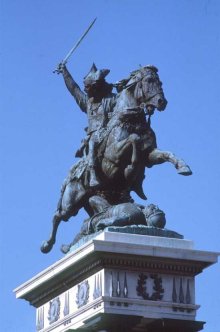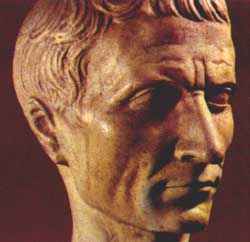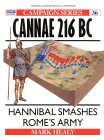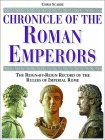Wars in Gaul
Gaul as a whole consisted of a multitude of states of different ethnic origin. In the Iron Age, their different cultures had started to resemble each other, largely by processes of trade and exchange. The Greeks and Romans called all these people Celts or Gauls. In the fourth century, Gallic warriors had settled along the Po and had invaded Central Italy (capturing Rome in 387). Most people in Italy were afraid of new Gaulish invasions.
 In the second century mass migrations from Germans had started, for reasons that are unclear. Marius had defeated some of their tribes (the Teutones and the Cimbri), but in Caesar's days it was probably not a gross exaggeration to say that the states of Gaul would have to become Roman or would be overrun by Germans, who would proceed to attack Italy. If the Romans were afraid of the Gauls, the were terrified of the Germans. In Caesar's propaganda, an invasion of Gaul was a preventive war. Maybe Caesar was not blind to trade: the Rhone-Saone-Rhine- corridor was the most important trade route in pre-industrial Europe and a taste for Roman luxuries had already started in the Gaulish states along the Rhone and Saone. British tin was traditionally transported along the rivers Garonne and Seine.
Caesar's military base was the valley of the Rhone, which had been Roman from 123 onwards. In the valley of the Saone, the Aedui were faithful allies. When Caesar became governor of this region, the Helvetians (a nation in modern Switzerland) had decided to invade the region along the Rhone and Saone, and it was obvious to Caesar that if he was able to defeat these roaming Germans, he could impress the Senate. Besides, a victory over the Germans would place him on the same rank as his uncle Marius. This is exactly what happened: after raising two extra legions, he defeated the Helvetians, once when they were crossing the Saone and a second time in the neighbourhood of the capital of the Aedui, Bibracte. After these victories, the Gauls are said to have asked Caesar to help them pushing back Germans, who had crossed the Rhine and settled in Alsace. Again, Caesar was victorious, and winter quarters were built in the neighbourhood of the battle field, in modern Besancon.
In the second century mass migrations from Germans had started, for reasons that are unclear. Marius had defeated some of their tribes (the Teutones and the Cimbri), but in Caesar's days it was probably not a gross exaggeration to say that the states of Gaul would have to become Roman or would be overrun by Germans, who would proceed to attack Italy. If the Romans were afraid of the Gauls, the were terrified of the Germans. In Caesar's propaganda, an invasion of Gaul was a preventive war. Maybe Caesar was not blind to trade: the Rhone-Saone-Rhine- corridor was the most important trade route in pre-industrial Europe and a taste for Roman luxuries had already started in the Gaulish states along the Rhone and Saone. British tin was traditionally transported along the rivers Garonne and Seine.
Caesar's military base was the valley of the Rhone, which had been Roman from 123 onwards. In the valley of the Saone, the Aedui were faithful allies. When Caesar became governor of this region, the Helvetians (a nation in modern Switzerland) had decided to invade the region along the Rhone and Saone, and it was obvious to Caesar that if he was able to defeat these roaming Germans, he could impress the Senate. Besides, a victory over the Germans would place him on the same rank as his uncle Marius. This is exactly what happened: after raising two extra legions, he defeated the Helvetians, once when they were crossing the Saone and a second time in the neighbourhood of the capital of the Aedui, Bibracte. After these victories, the Gauls are said to have asked Caesar to help them pushing back Germans, who had crossed the Rhine and settled in Alsace. Again, Caesar was victorious, and winter quarters were built in the neighbourhood of the battle field, in modern Besancon.


|










 Actual footage from ancient Rome
Actual footage from ancient Rome 

